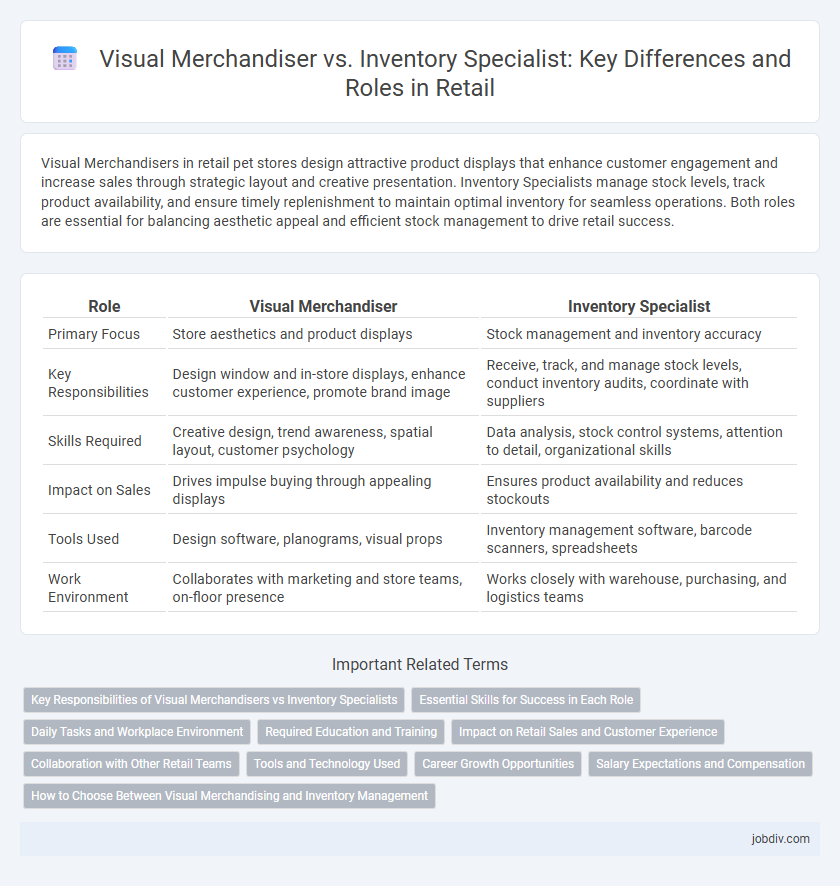Visual Merchandisers in retail pet stores design attractive product displays that enhance customer engagement and increase sales through strategic layout and creative presentation. Inventory Specialists manage stock levels, track product availability, and ensure timely replenishment to maintain optimal inventory for seamless operations. Both roles are essential for balancing aesthetic appeal and efficient stock management to drive retail success.
Table of Comparison
| Role | Visual Merchandiser | Inventory Specialist |
|---|---|---|
| Primary Focus | Store aesthetics and product displays | Stock management and inventory accuracy |
| Key Responsibilities | Design window and in-store displays, enhance customer experience, promote brand image | Receive, track, and manage stock levels, conduct inventory audits, coordinate with suppliers |
| Skills Required | Creative design, trend awareness, spatial layout, customer psychology | Data analysis, stock control systems, attention to detail, organizational skills |
| Impact on Sales | Drives impulse buying through appealing displays | Ensures product availability and reduces stockouts |
| Tools Used | Design software, planograms, visual props | Inventory management software, barcode scanners, spreadsheets |
| Work Environment | Collaborates with marketing and store teams, on-floor presence | Works closely with warehouse, purchasing, and logistics teams |
Key Responsibilities of Visual Merchandisers vs Inventory Specialists
Visual Merchandisers focus on designing attractive product displays, enhancing store aesthetics, and influencing customer buying behavior through strategic layout and presentation techniques. Inventory Specialists manage stock levels, conduct regular inventory audits, and coordinate with supply chain teams to ensure accurate product availability and timely replenishment. Both roles are essential in retail operations, balancing customer engagement with efficient stock management.
Essential Skills for Success in Each Role
Visual Merchandisers excel in creativity, spatial awareness, and trend analysis to design engaging store displays that attract customers and drive sales. Inventory Specialists require strong analytical skills, attention to detail, and proficiency in inventory management systems to ensure accurate stock levels and efficient supply chain operations. Both roles demand effective communication and teamwork to align merchandising strategies with inventory availability for optimal retail performance.
Daily Tasks and Workplace Environment
Visual merchandisers design and implement attractive product displays to enhance customer experience and drive sales, working primarily on the retail floor with creative tools and materials. Inventory specialists manage stock levels, track shipments, and organize storage areas to ensure product availability, often operating behind the scenes in warehouses or stockrooms. Both roles require attention to detail, but visual merchandisers engage more with customer-facing environments while inventory specialists focus on logistics and stock accuracy.
Required Education and Training
Visual Merchandisers typically require a background in fashion design, marketing, or visual arts, often holding a bachelor's degree in these fields to effectively create appealing store displays. Inventory Specialists usually possess a diploma or associate degree in supply chain management, logistics, or business administration, coupled with practical training in inventory control systems. Both roles benefit significantly from experience with retail software and hands-on training to enhance operational efficiency and store presentation.
Impact on Retail Sales and Customer Experience
Visual Merchandisers enhance retail sales by strategically designing store layouts and product displays that attract and engage customers, boosting impulse buys and overall foot traffic. Inventory Specialists optimize stock levels and product availability, minimizing out-of-stock scenarios and ensuring a seamless shopping experience. Together, these roles directly influence customer satisfaction and sales performance through complementary focus on visual appeal and inventory management.
Collaboration with Other Retail Teams
Visual Merchandisers collaborate closely with marketing and sales teams to create engaging store displays that drive customer engagement and increase sales performance. Inventory Specialists work with purchasing, logistics, and sales departments to maintain accurate stock levels and ensure product availability aligns with seasonal promotions and visual merchandising strategies. Effective communication between both roles enhances inventory turnover and optimizes the in-store customer experience.
Tools and Technology Used
Visual Merchandisers utilize design software like Adobe Creative Suite and 3D modeling tools to create appealing store layouts and product displays that drive customer engagement. Inventory Specialists rely heavily on inventory management systems (IMS) and barcode scanning technologies to maintain accurate stock levels and streamline replenishment processes. Both roles integrate data analytics platforms for performance monitoring but apply these tools differently to optimize retail operations.
Career Growth Opportunities
Visual Merchandisers often experience career growth by advancing to roles such as Visual Merchandising Manager or Creative Director, leveraging their expertise in aesthetic presentation and brand storytelling. Inventory Specialists may progress to positions like Inventory Manager or Supply Chain Analyst, where they optimize stock control and logistics management. Both paths offer specialized skill development, but Visual Merchandising careers typically emphasize creativity and consumer engagement, while Inventory roles focus on analytical and operational efficiency.
Salary Expectations and Compensation
Visual Merchandisers typically earn between $45,000 and $65,000 annually, with compensation reflecting creativity and brand presentation skills critical for driving sales. Inventory Specialists have a salary range of $40,000 to $60,000, emphasizing accuracy in stock management and supply chain efficiency as key value factors. Bonuses and performance incentives are common for both roles, often tied to store profitability and operational excellence.
How to Choose Between Visual Merchandising and Inventory Management
Visual merchandisers enhance in-store customer experience by designing appealing product displays using color theory, lighting, and layout strategies that boost sales and brand identity. Inventory specialists optimize stock levels through demand forecasting, data analysis, and supply chain coordination to minimize costs and prevent stockouts or overstock situations. Choosing between these roles depends on whether the priority is increasing visual appeal and customer engagement or ensuring efficient inventory control and operational accuracy.
Visual Merchandiser vs Inventory Specialist Infographic

 jobdiv.com
jobdiv.com